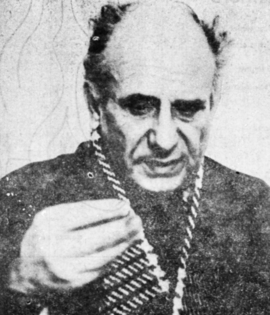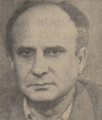Dimitrie Stelaru facts for kids
Quick facts for kids
Dimitrie Stelaru
|
|
|---|---|

Stelaru during an interview with Adrian Păunescu for România Literară, 1969
|
|
| Born | Dumitru Petrescu 8 March 1917 Segarcea-Vale, Teleorman County, German-occupied Romania |
| Died | 28 November 1971 (aged 54) Bucharest, Socialist Republic of Romania |
| Occupation |
|
| Period | c. 1935–1971 |
| Genre |
|
| Literary movement |
|
| Signature | |
 |
|
Dimitrie Stelaru (born Dumitru Petrescu, later known as Petrescu-Stelaru; March 8, 1917 – November 28, 1971) was a famous Romanian poet, writer, and playwright. He was known for his unique and adventurous life. Born in a small village in Teleorman County, he lost his father when he was very young during World War I.
He was adopted by a bricklayer who encouraged him to join the Seventh-day Adventist Church. As a teenager, Stelaru chose a different path and started writing poetry. He often moved around, working many different jobs like a porter, coal miner, or day laborer. He lived in great poverty in Bucharest and wrote many early love poems about a woman he cared for deeply.
Even though he faced many challenges, Stelaru became a respected writer. His poems often mixed old romantic styles with new, modern ideas. He was influenced by writers like Edgar Allan Poe and was part of a group of artists who explored new ways of writing, like Surrealism. He became well-known among younger writers and was welcomed by important literary groups.
During World War II, Stelaru even faked his own death as a joke! After the war, he worked as an art teacher. When a new communist government came to power in Romania, his writing was banned for a while. He struggled but eventually was allowed to publish again, especially children's stories and plays. In his later years, he wrote many new poems and plays, some of which explored unusual ideas. He passed away in 1971, leaving behind a rich collection of works that were rediscovered and celebrated years later.
Contents
Dimitrie Stelaru's Early Life and Education
Dimitrie Stelaru was born Dumitru Petrescu on March 8, 1917. His father, a boot-maker and farmer, died in World War I before Stelaru was born. His mother, Pasca, later remarried Florea Stoicea, a bricklayer.
Childhood and Family Changes
Young Dumitru, known as "Mitea," was baptized in the Romanian Orthodox Church. When he was seven, his family moved to Turnu Măgurele. His stepfather encouraged the family to join the Seventh-day Adventist Church.
Mitea and his stepfather often disagreed. His stepfather wanted him to learn practical skills, but Mitea loved books and writing.
School Days and Rebellion
After primary school, Mitea attended high school in Turnu Măgurele. In 1931, he went to a religious school run by Adventists in Brașov County. He did not like the strict rules and vegetarian diet there.
In 1935 or 1936, he ran away from the school. He then moved to Bucharest and lived a life of wandering. He often slept in homeless shelters or shared a small home with a young woman named Olivia or Maria-Maria.
Working and Learning on His Own
Stelaru took on many different jobs to survive. He worked as a porter at train stations and ports in cities like Constanța and Brăila. He was also a day laborer in Sighișoara and a coal miner in the Jiu Valley.
He never officially graduated from a university, but he read a lot and taught himself. He was especially inspired by writers like Edgar Allan Poe. His first poems were influenced by the Romanian classic Mihail Eminescu.
Becoming a Poet: Dimitrie Stelaru's Debut
Stelaru's first poetry book, Melancolie ("Melancholy"), was published in 1935. He used the pen name D. Orfanul ("D. The Orphan") for this book, which mostly contained religious poems.
New Name, New Beginnings
In 1938 or 1939, poet Eugen Jebeleanu suggested a new pen name: Dimitrie Stelaru, meaning "The Stellar One." Stelaru liked this name and later made it his legal surname.
Under his new name, he started writing for literary magazines. He also interviewed many people, and his interviews appeared in daily newspapers.
Joining Literary Circles
Stelaru became part of a group of young writers. He was seen as a mentor by poets like Miron Radu Paraschivescu and Geo Dumitrescu. He also helped introduce his friend Constant Tonegaru to Surrealism, a style of art and writing.
He sometimes visited the Sburătorul literary circle, led by Eugen Lovinescu. Lovinescu described Stelaru as quiet among other writers. In 1939, Stelaru won a literary prize from România Literară magazine.
The Famous Death Hoax
In 1940, Stelaru played a famous prank: he announced his own death in a newspaper! The news spread, and many people, including other writers, believed it. They even wrote obituaries for him.
His relatives traveled to Bucharest to pick up his coffin, only to find Stelaru alive and well, enjoying the stir he had caused. This prank showed his playful and rebellious side.
Wartime and Literary Challenges
During the early years of World War II, Stelaru continued to write. He published poems in the literary journal Albatros, which was started by Geo Dumitrescu in 1941. His poems often celebrated individual freedom.
Avoiding Military Service
Stelaru managed to avoid military service during the war. He told authorities he had many younger siblings to care for and a medical condition.
Important Works and Style
Two of Stelaru's most important poetry collections, Noaptea geniului ("A Night of Genius") and Ora fantastică ("That Fantastic Hour"), were published during this time. These books showed his unique style, which combined elements of Expressionism and Neo-Romanticism.
His poems often described his difficult life, but he transformed his struggles into beautiful and moving verses. Critics noted how he could create powerful visions with few words.
Stelaru's Unique Voice
Stelaru's poetry was different from other writers of his time. Even though he was poor, he wasn't interested in political or revolutionary themes. He preferred to explore personal feelings and dreamlike ideas.
He often used nicknames for himself in his poems, like "the vagabond angel," to show his restless spirit. His poems often spoke about his struggles and his search for happiness.
Life Under Communism and Return to Writing
After World War II, the government in Romania changed to a communist system. This brought new challenges for Stelaru.
Censorship and Struggles
In 1945–1946, Stelaru taught art in Sighișoara. He also started writing children's stories. However, after 1947, the new communist government restricted nonconformist literature. Stelaru's works were banned, and he was not allowed to join the official Writers' Union of Romania.
He even tried to secretly leave the country by ship from Port of Constanța with friends, but their plan failed. For several years, he was unemployed and isolated.
Writing for Children
Despite the ban on his adult works, Stelaru was eventually allowed to publish children's literature. He wrote "lyrical fairy tales" like Fata pădurarului ("The Forester's Daughter", 1955) and Gelu (1956), a long poem inspired by Romanian folklore.
He also wrote children's plays, such as Șarpele Marao; Vrăjitoarele ("Marao the Snake; The Witches", 1957). These works were praised for their simple, clear language and imaginative stories.
Gradual Rehabilitation
In the early 1960s, Stelaru slowly began to be accepted back into the literary world. He started publishing again in literary journals. His poems described everyday life and the joy of new beginnings.
In 1963, his book Oameni și flăcări ("Men and Flames") appeared. This collection included poems about workers and anti-war themes, showing a shift in his writing to fit the times.
Final Years and Lasting Impact
By 1964, Stelaru was fully "rehabilitated" and recognized by the Writers' Union. He was given his first permanent home, an apartment in Berceni, where he lived with his third wife and young son, Vlad Eunor.
A Productive Period
Between 1967 and 1971, Stelaru wrote a large number of poems and stories. His book Mare incognitum (1967) was considered a very important work and won him a prize from the Writers' Union.
He also wrote new plays that explored unusual and philosophical ideas, sometimes similar to Theatre of the Absurd. He enjoyed spending time with his son, whom he called "Little Cloud."
Last Works and Passing
Stelaru continued to publish new books, including Înalta umbră ("The Tall Shadow") and Poeme dramatice. Leru ṣi Împăratul Nix ("Dramatic Poems. Leru and Emperor Nix") in 1970. His last collection, Păsări incandescente ("Incandescent Birds"), came out in 1971.
Dimitrie Stelaru passed away in Bucharest on November 28, 1971. He was buried in Bellu cemetery among other writers. His friend, Ion Caraion, remembered him as "one of this country's great true poets."
Dimitrie Stelaru's Legacy
Dimitrie Stelaru's unique life and powerful poetry continued to be remembered in Romanian literature. He influenced younger poets, and his work was seen as a blend of dramatic life experiences and spiritual creation.
Rediscovery and Commemoration
For many years after his death, some of Stelaru's works were not widely available. However, in the 1980s, researchers began to explore his life and writings more deeply. His children's literature, like Vrăjitoarele, was even adapted for puppet theater.
After the fall of communism in 1989, more of Stelaru's unpublished writings were brought to light. In 2017, a memorial plaque was placed on his first home in Segarcea-Vale to celebrate his 100th birthday. A museum exhibit dedicated to him opened in 2018.
Stelaru's work continues to be studied and appreciated, ensuring his place as an important figure in Romanian literature.
Images for kids



